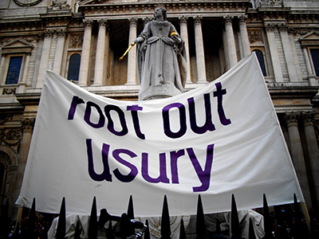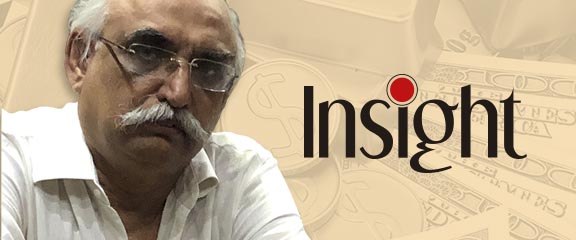I am a believer in the evolution and development of human intellect aimed at establishing a just society. Interest and usury are socio-economic subjects and can be handled by the human intellect. My research shows that there has been a stagnation in the thought process while applying divine revelations on this subject. Human intelligence has identified solutions that need to be read and divine revelations for a workable solution. There is an urgent need to recognise developments over time and appreciate various societies’ corrective actions to curb usury and limit its negative impact. In this flat world, no state can operate in isolation from a well-knit international financial world. Therefore, this article attempts not just to open debate but also to propose a way forward.

Informal Banking and Exploitation of the Masses: Pakistan, which has a high prevalence of cash economy, faces the real menace of usury because of informal banking, where the monthly interest rate ranges between 2.0-5.0 percent. This is the leading cause of financial degradation of agricultural communities and high margins for intermediaries, who undertake the multiple businesses of money lending and trade. I term it as Arthi mafia. This system has not changed for centuries, and even today, our state of affairs remains like medieval societies. Unfortunately, as a society, we indulge in debates about the prohibition of Riba without understanding the evolution of the financial world, which is integrated. I am not a scholar of Islamic Fiqah (jurisprudence), but I consider myself a reasonably good student of finance. In my view, it is the subject of socio-economic behaviour and not of Fiqah.
In the following paragraphs, I will dilate on this issue with particular emphasis on the evolution of commercial banking and “Ijtihad” (interpretations) after considering the development of human intellect, which was ratified by divine revelations. However, such interpretation should be made by economic, financial, and accounting experts rather than by those who correlate irrelevant traditions from unauthenticated sources. Many enlightened and practical persons, including Sir Syed Ahmad Khan, took up this important subject in the late 19th century, which will be discussed in the following paragraphs.
To understand the system of implied usury, it is essential to illustrate a transaction. There are money lenders in the market who provide loans to agriculturists. These money lenders do not recover interest on their loans. While giving loans, they agree that they will buy the product cultivated at a price minus a sum. That sum is the implied interest on that loan. For example, if Rs. 500,000 are lent, the transaction is of an advance purchase of crop at a price to be decided at the time of delivery. Suppose the market price of a product is Rs. 600,000. Under this contract, it will be Rs. 600,000 minus interest accrued on Rs. 500,000 at the rate of 3 percent per month from the date of the lending to the date of delivery.
In this manner, the moneylender acquires the product at say Rs. 550,000 and sells it at Rs. 600,000 at the minimum. Fake scholars of sacred texts declare Rs. 50,000, thus earned by the moneylender as a kosher transaction. This is a common practice and currently covers around 80 percent of the agricultural product market. The problem is not the role of these fake scholars, who give a wrong interpretation of the sacred text, but as with the masses, who are ignorant. Even in the 60th Hijri (Islamic calendar year), there were such scholars who approved the rule of Yazid. Even then, the dispute was about substance versus form. An unjust de-facto ruler cannot claim de-jure authenticity.
Condemnation of Usury is Universal: All the Abrahamic religions — Judaism, Christianity, and Islam — prohibit interest (or excess interest). However, many human societies took up the issue of prohibition much before these divine revelations appeared. The divine revelations adopted many just principles, which were already in vogue in primitive societies. The Abrahamic religions also reflected upon this concept, intending to establish just communities. Indeed, the divine corroborates the human intellect if it is for the common good. This may be the reason for a short description of the subject in religious texts, limiting itself to punishments for the people who indulge in usury. The issue itself has been thrashed out in most societies as they reached one conclusion that usury is harmful. The following paragraphs discusses this briefly.
The concept of “usury” has a long history and has been understood as ‘the practice of charging financial interest over the principal amount of a loan.’ However, in some instances, especially in recent times, it has been interpreted as ‘interest above the legal or socially acceptable rate.’

Accepting this broad definition for the moment, the practice of usury can be traced back to approximately 4,000 years ago. It has been repeatedly condemned, prohibited, scorned, and restricted mainly on moral, ethical, religious, and legal grounds. The Abrahamic holy texts of Judaism, Christianity, and Islam continued this tradition. Hinduism and Buddhism have also been among usury’s most visible and vocal critics. Ancient Western philosophers and politicians and various modern socio-economic reformers can also be added to this list. There is the history behind this critique of usury which carries on even in today’s predominantly interest-based global economy.
The earliest such record derives from the Vedic texts of Ancient India (2,000-1,400 BC), in which the “usurer” (kusidin) is mentioned several times and interpreted as any lender who charges interest. More frequent and detailed references to interest payment are to be found in the later Sutra texts (700-100 BC) and the Buddhist Jatakas (600-400 BC). It is during this latter period that the first sentiments of contempt for usury are expressed. For example, Vasishtha, a well-known Hindu law-maker of his time, made a particular law, which forbade higher castes of Brahmanas (priests) and Kshatriyas (warriors) from being usurers or lenders at interest. Also, in the Jatakas, usury has been mentioned in a demeaning manner; “hypocritical ascetics are accused of practicing it.”
By the second century AD, however, usury had become a more relative term, as is implied in the Laws of Manu of that time: “Stipulated interest beyond the legal rate being against (the law), cannot be recovered and called a usurious way (of lending).” This dilution of the concept of usury seems to have continued through the remaining course of Indian history. Today, while usury is still condemned in principle, it refers only to interest charged above the prevailing socially accepted range and is no longer prohibited or controlled.
Ancient Western philosophers, who condemned usury, include Plato, Aristotle, the two Catos, Cicero, Seneca, and Plutarch. These thoughts are reflected in the civil law of that period. For example, the Lex Genucia reforms in Republican Rome (340 BC) outlawed interest altogether. Nevertheless, in practice, ways of evading such legislation were found, and by the last period of the Republic, usury was again rife.
It was the democrats in Rome, who rededicated themselves to the cause of those suffering the burden of debt, and under the banner of Julius Caesar, a ceiling on interest rates of 12 percent was set, and later under Justinian, lowered to the level of 4 percent to 8 percent. This may be the first Central Bank discount rate concept. We cannot reject what Caesar and Justinian did. They were democratically elected rulers of a civilised society of that time.
The aforesaid historical record demonstrates that humanity faced the challenge of usury over thousands of years, and rulers like Caesar were so advanced that they prescribe a ‘maximum’ rate of interest. Therefore, it is so unfortunate that in today’s Pakistan, people still face this injustice. Some 1,400 years ago, Hazrat Ali (AS) had said that a society could survive with kufr (infidelity), but not injustice.”
Everybody knows about the problem, but like an ostrich, we bury our heads in the sand. We divert attention from this social issue through the incorrect and incomplete interpretation of divine revelations. This is social treachery, which is not a new phenomenon in human history.
Modern Economists and Usury: Some may be surprised to discover that Adam Smith, despite his image as the “father of free-market capitalism” and general advocacy of laissez-fair economics, came out strongly in support of controlling usury. While he opposed a complete prohibition of interest, he was in favour of the imposition of the interest rate ceiling. This, he felt, would ensure that low-risk borrowers, who were likely to undertake socially beneficial investments, were not deprived of funds because “the greater part of the money, which was… being lent to prodigals and projectors (investors in risky, speculative ventures), who alone would be willing to give an unregulated high-interest rate.”
The great 20th-century economist John Maynard Keynes believed that; “the disquisitions of the schoolmen [on usury] were directed towards elucidation of a formula, which should allow the schedule of the marginal efficiency to be high, whilst using rule and custom and the moral law to keep down the rate of interest, so that a wise government is concerned to curb it by statute and custom and even by invoking the sanctions of the Moral Law.”
Another lesser-known anti-usury economic reformist was Silvio Gesell — a successful 19th Century merchant in Germany and Argentina. They condemned interest because his sales were more often related to the ‘price’ of money (i.e., interest) than people’s needs or the quality of products. His proposal of making money a public service, subject to a use-fee, led to widespread experimentation in Austria, France, Germany, Spain, Switzerland, and the United States under the banner of the so-called “stamp script movement.” But these initiatives were squashed when their success threatened the banking monopolies.
Margret Kennedy, a German professor, is one of the most vocal contemporary critics of interest, who builds on Gesell’s ideas, believing that “interest … acts like cancer in our social structure.” She takes up the cause for “interest and inflation-free money” by suggesting a modification of banking practice to incorporate a circulation fee on money, acting somewhat like a negative interest rate mechanism.
Finally, another school of modern critics of interest has roots in the complementary work of socio-economic reformists of the early 20 Century, including Douglas, Fisher, Simons, and Soddy. Their chief familiar premise was that it is wrong and unacceptable for commercial banks to monopolise the money or credit creation process. For banks to then charge interest on money, which they had in the first place created out of nothing and having suffered no opportunity cost, amounted to nothing less than an immoral and fraudulent practice. The original authors proposed various alternative systems carried forward by their modern-day torch-bearers, such as the Social Credit Secretariat and the Committee on Monetary and Economic Reform.
Human Society’s Quest to Abolish Usury: This shows humanity’s constant struggle against usury and attempts to balance its oppressive nature and money and banking. Therefore, the so-called evils of usury must be understood as connected with money and a socio-psychological construct legitimised by the power dynamics of a given political economy, which may or may not be democratically and consciously justifiable.
This can be seen in the Christian tradition, where Jesus is asked whether taxes should be paid to Caesar? Before uttering the famous words, “render unto Caesar what is Caesar’s,” he tellingly first questions to be shown a coin and inquires, “whose image and superscription hath it? (Luke 20:24).” In other words, “what power structure legitimises this currency?” Jesus’ response said much more than “pay your taxes.”
Usury & Money: Usury marks the distinction between money being only a socially contracted abstract mechanism to meet supply and demand and money as an end in itself. As an end in itself, money as a commodity legitimised tax economic activities through usury, thus short-circuiting the natural process of living by the sweat of one’s brow. The money thus becomes self-perpetuating power in itself rather than just a mediating agent. And it is the relentlessness of compound interest in the face of adversity that sets the potential cruelty of usury apart from equity-based return on investment. One can see how it is the love of money as an end in itself, not the use of money, that is the root of all evil. It was in recognition of the need to have corrective feedback mechanisms that Islam not only adjuncts usury but also imposes zakat (wealth tax).
More radical still, the Old Testament proposes a complete economic readjustment through the “Jubilee” process every fifty years (Leviticus 25). However, there is no evidence that such whole-scale redistribution of wealth in all forms was ever carried out. Perhaps it is a prophetic vision whose time has yet to come.
This is also the reason why in Islam, God “permits trade, yet forbids usury.”
“The difference is that profits are the result of initiative, enterprise, and efficiency. The result after a definite value-creating process. Not so with interest.” Also, “interest is fixed, (while) profit fluctuates. In the case of interest, you know your return and can be sure of it. For-profit, you have to work to ensure it. Perhaps Aristotle had a similar idea in mind when he argued that “a piece of money cannot beget another.”
Logical Arguments Against Usury: The Church’s most straightforward and perhaps earliest objection to usury was on the basis that it constituted unearned income. This idea stemmed from its general doctrine of ‘Just Price.’
The Lateran Council of 1515 clearly expressed the Church’s interpretation; “Usury, when the gain is sought to be acquired from the use of a thing, not in itself fruitful (such as a flock or a field) without labour, expense or risk on the part of the lender.” Birnie reinforces this point by noting that “to live without labour was denounced as unnatural, and so Dante put usurers in the same circle of hell as the inhabitants of Sodom and other unnatural vices.” Here, we should not forget that there is a clear statement that the last text is the continuation of earlier texts.
The condemnation of usury in charging for loans to the poor and needy is a recurring theme in several traditions. The medieval usury laws’ original target was the medieval equivalent of the loan sharks’ [but] “the medieval theory was unsatisfactory because it could not distinguish the helpful loan from the oppressive.”
Sir Syed’s school in Islam similarly interprets riba as the primitive form of money-lending when it was advanced for consumption purposes.” In the Indian tradition, this understanding of usury can also be found, as is evident from this 20th-century quote; “It is usury — the rankest, most extortionate, most merciless usury — which eats the marrow out of the bones of the raiyat [cultivators] and condemns him to a life of penury and slavery.”
A 1992 Policy Studies Institute report concludes that the poor pay more in absolute terms for their money while seeking credit only for absolute necessities rather than finance the acquisition of luxury goods, which they cannot afford. The National Consumer Council’s 1995 study on financial services and low-income consumers says, quoting a respondent that “it’s like being caught, gotcha, and then they [the banks/lenders] start winding you in.”
A modern parallel argument relates to the devastating social impact of the so-called “Third World debt crisis,” a situation which even Pope John Paul II acknowledges in his Sollicitude Rei Socialis when he states that “capital needed by the debtor nations to improve their standard of living now has to be used for interest payments on their debts.”
In this context, it is fitting to observe that a critical feature that distinguishes financial economy from nature’s economy is that the one operates on a compound interest basis, whereas the other on simple interest. Money deposited in the bank may yield 10 percent plus interest on the compounded sum next year, but in nature, if you leave this year’s crop of apples on the tree, you are unlikely to pick a compounded heavier yield next year. Accordingly, usury permits a disjunction between the financial and ecological economy. The result is either the progressive destruction of nature or in the absence of redistributive social justice, an inbuilt necessity for periodic financial crashes. The illustration well makes the point that if Judas Iscariot had invested his 30 pieces of silver at just a few percentage points compound repayable in silver as of today, the amount of silver required would be equivalent to the weight of the Earth.
Interest & Usury: The standard definition of interest in return, profit, or gain, whereas ‘usury’ is defined as extortion, overcharging, and daylight robbery. I have intentionally not tried to explain the term Riba because by divulging in that issue, we will lose sight of the central point of exploitation of humanity by usury, which other societies have also tried to address.
Similarly, I have restrained to enter into the distinction between interest and usury. What is to be said is implied in the following paragraphs. The secondary question that arises in our case is whether isolated abolition of interest can be done within a financial framework of the state. The world at large is built on the money concept and value of capital. Any isolationist approach will either die intrinsically or compromise on the principles for which the whole structure is deemed to be built. The primary objective of any society is the establishment of social justice. Usury ranks first on this list. This objective has been achieved through a logical process in almost all developed societies. It is necessary that we also follow the advanced civilisations’ route, avoiding uneducated interpretations of divine revelation.

The simple question is whether an ordinary farmer in Europe faces the same situation as a Pakistani farmer. If the state stands impartial on this exploitation, then it means there can be no justice in the society. If so, divine revelations remain just a text. There is a need to understand what has been done in advanced countries to end exploitation. Now, this is our job how we do it as there will be no more divine revelations.
History & Human Intellect: It is established that usury is harmful to society. Now the question is whether human civilisation has come up with any solution? The answer will be found in pure economics and not in historical traditions.
Need for finance: In every society, there is always a need for financing to match the gap between the expenses incurred over time and the income arising with intervals. In simple terms, in the case of agricultural activities, there are constant outflows by the farmer on consumption and cost of inputs. In contrast, receipts are delayed for over six to seven months. This gap is bridged by various means of financing. The historical manner was borrowing from Banias (moneylenders). Like any other economic activity, the financial strength of the borrower versus the lenders determines the cost of financing.
In most societies, the cost of this kind of borrowing is generally high, exploiting the borrowers. A major part of politico-historical events in the world is directly or indirectly revolts by borrowers against the lenders. This is one of the reasons for the holocaust in Europe in the 1940s. Another cause of social unrest had been high and discriminatory taxes.
Unfortunately, in Pakistan, the masses suffer from both — a high informal, implicit or actual interest rate on borrowings and excessive direct and indirect taxes. We are still passing the rudimentary stages of civilisation compared to the developed world, where all these issues have been settled. Unless these two basic economic issues are not sorted out, there cannot be sustainable peace.
Artificial Person & Limited Liability: Here, I will discuss human intellect’s results in trying to resolve this issue. The most important, apparently unrelated development for the avoidance of usury from the market was introducing joint-stock companies with limited liability and the concept of an artificial juridical person. There is a basis and a sense behind the evolution of this concept, which has a direct relationship with the elimination of usury. Under the idea of joint-stock companies, an artificial person with limited, perpetual liability is created. That person is not an individual but an existence recognised under the law. All the societies in the world, including Pakistan, have adopted the concept of joint-stock companies. The place where the joint-stock companies idea links up with eliminating usury is the concept of ‘limitation of risk’ and ‘pooling of funds.’ One of the main reasons for the high cost of lending was the risk related to the amount’s non-recoverability. This risk has been limited to the amount of capital invested in that joint-stock company, being a lender, by an individual. Thus, in this manner, the artificial person, actually being a shock absorber, has been inducted between the borrower and the lender. In the case of the borrower, the risk of loss of personal property has been eliminated by inserting a limited liability company. Since the amount contributed by an individual may not provide sufficient funds, a concept of pooling of capital is ingrained in every joint-stock company, which is engaged in lending is generally called a ‘bank.’
When the element of non-recoverability is limited to the amount of capital invested in that company or the amount lent is borrowed through deposits, then the effective cost of financing naturally balances with the market situation, and usury is automatically eliminated. The difference is called the bank’s spread. Transactions in these cases are between two artificial juridical persons with limited liability. Therefore, the question of usury does not arise. This is the primary measure through which usury was eliminated substantially in the developed societies. This method is kosher as the primary issue of high interest and exploitation is intrinsically eliminated. The concept of usury does not arise between two artificial juridical persons. And the concept of limited liability cannot be ignored. This is the essence of the modern financial market.
Another Artificial Person — The State: Constitution of another artificial person — the ‘State’ — is also essential. The state replaces Caesar. All states make it mandatory that only the instrument issued by her will be used as a medium of exchange. Also, the state is entitled to borrow from the people, repaid by printing more currency. Lending to the state is directly related to the value of money. This ‘complicated equation’ is reflected by the discount rate, which an artificial person, the state, pays to the lender. There can be a rate as high as 20 percent and above, whereas states also prescribe zero or negative rates. The primary question is whether such borrowing can be avoided? If not, then whether such borrowing with a guaranteed interest can be termed usury or Riba? The answer is an emphatic no. A state is an artificial person, represented by all citizens. If we take out the state’s concept from modern finance, then the entire system will collapse. One state in the world is a dream. Human prejudices and contradictions do not allow it. The European Union has contracted over a period of time. Instead of a utopia, we should live in reality. This positively requires interpretation of divine revelation instead of adopting a rejectionist approach.
Economics of Interest: What is interest? In economics, the rate of interest is the price of credit, and it plays the role of the cost of capital. In a free-market economy, interest rates are subject to the law of supply and demand of the money supply. One explanation of interest rates higher than zero is the scarcity of loanable funds.
Over centuries, various schools of thought have developed explanations of interest and interest rates. The School of Salamanca justified paying interest in terms of the benefit to the borrower and the lender’s interest in terms of a premium for the risk of default. In the 16th century, Martin de Azpilcueta applied a time preference argument saying that it is preferable to receive a given good now than in the future. Accordingly, interest is compensation for the time the lender forgoes the benefit of spending the money.
On why interest rates are usually greater than zero, in 1770, a French economist proposed the theory of fructification. By applying an opportunity cost argument, comparing the loan rate with the rate of return on agricultural land, and a mathematical statement, using the formula for the value of infinity to a plantation, he argued that the land value would rise without limit, as the interest rate approached zero. For the land value to remain positive and finite, keep the interest rate above zero.
Adam Smith also propounded theories of interest rates. Swedish economist Knut Wicksell in his 1898 work, ‘Interest and Prices,’ elaborated a comprehensive view of economic crises based upon a distinction between natural and nominal interest rates. In the 1930s, Bertil Ohlin and Dennis Robertson refined Wicksell’s approach, which became known as the loanable fund theory. This proves that the human mind is continuously looking for equity and justice. Divine does not interfere.
What’s the Cost of Loan? In simple words, three fundamental reasons determine interest.
a) First, when people lend money, they no longer use it to fund their purchases. The interest payment makes up for this loss.
b) Second, a borrower may default on the loan, and the lender loses the money. Interest helps to make the risk of default worth taking. Generally, the greater the risk of loan default, the higher the interest rate.
c) Finally, and most importantly, lenders demand interest because while the borrower has the money, inflation tends to erode the loan’s value or purchasing power. In this case, interest maintains the real value of the balance due.
There is an argument that abstinence from any other use of the loaned amount and compensation for the lost opportunity cost is a trade and one factor of production. This resolves the issue of trade versus lending. By charging an interest rate at least equal to the rate of inflation, this problem is corrected. The effects of inflation and the interest rate counteract each other so that the money’s real value stays the same, even though the nominal value of the money increases.
If we become ultra-conservative, then we will have to eliminate the concept of a fixed return on savings from society. But is this utopian model workable? Another question; is it our divine duty not to ask for a little return on savings? This would mean that all savings have to be used for trade with unlimited risk. In my opinion, a fixed return from an artificial person such as a bank or the state, is not against any divine revelations. In other words, what the developed societies designed remains closer to divine revelations than any different concept based on invalid and incomplete traditions. There is no guilt in my mind on this subject.
Checks and balances: There can be arguments for and against the premise above. However, all civilised societies have evolved four primary tabs checks on interest to avoid exploitation. The first check is that lending and borrowing have been placed in the hands of artificial juridical persons or corporate bodies with limited liabilities. For this reason, in every civilised society, there are different norms for ‘personal loans.’ The result of this evolution is that the chances of personal exploitation get limited to the business’s amount, and personal assets remain secured.
The second check is control of interest rate by another juridical person through the Central Bank. The rate charged by that institution is a universal benchmark for that society, and institutions can only add a cost factor to that base rate. The Central Bank regulates the loanable capital through various measures like capitalisation of banks etc.
The third aspect is the prohibition of any private lending that is tantamount to the equivalence of banking. In contrast, the last element is the common law prohibition through the ‘Contract Act’ according to which any exploitative agreement is ab-initio void.
These four checks remain in place in every civilised society and settle the centuries’ old usury issue. They may not be perfect, but the quest for perfection continues. This subject must be examined holistically. Divine revelations give broad guidelines but do not indulge in the nitty-gritty. They only say that usury is to be universally condemned, which means that economic caveats, as discussed above, have to be placed to avoid exploitation of individuals, which is the divine objective.
Way Forward: Under these circumstances, the State Bank of Pakistan should immediately stop informal banking in the name of trade against the advance paid to the grower (i.e., advance purchase at a price less than the market). This absolute usury should not be acceptable. Instead of spending time designing transactions not complying with the principle of substance over form with Arabic names, efforts must be made to abolish the prevalent menace of usury being done in the name of trade. Such agreements are ab-initio void. The state should protect borrowers. If this is not done, then it would mean that we as a nation are neither law-abiding nor following the divine revelations.

The writer is one of Pakistan’s best-known chartered accountants and a senior partner in A.F. Ferguson. He served as the 26th chairman of the Federal Board of Revenue.



